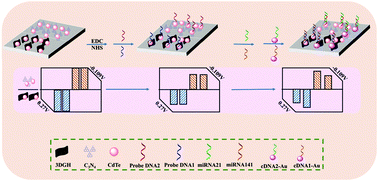A universal photoelectrochemical biosensor for dual microRNA detection based on two CdTe nanocomposites†
Abstract
Various diseases are closely related to simultaneous changes of multiple miRNAs expression levels. It's of great significance to develop photoelectrochemical (PEC) biosensors for multiple miRNA detection for both clinical diagnosis and biological mechanisms research. In this work we designed a novel PEC biosensor for simultaneous dual miRNA detection for the first time. Two nanocomposites, CdTe loaded carbon nitride nanosheets (CdTe-C3N4) with an anodic photocurrent and CdTe loaded 3D graphene hydrogel (CdTe-3DGH) with a cathodic photocurrent were prepared and showed enhanced PEC performances. Photocurrents of the two nanocomposites can be clearly distinguished at the corresponding critical voltages. Then probe DNA1 and DNA2 were combined with CdTe-3DGH and CdTe-C3N4 NCs through covalent bonding respectively. With the competitive hybridization reaction between target miRNAs and the complementary DNA (cDNA), concentrations of miRNA141 and miRNA21 may be sensitively quantified by the respective photocurrent change. Compared with traditional PEC biosensors, this design didn’t require any additional equipment and can provide a higher detection efficiency, which has a good universality and expansibility for the fabrication of multiplex PEC assays.



 Please wait while we load your content...
Please wait while we load your content...